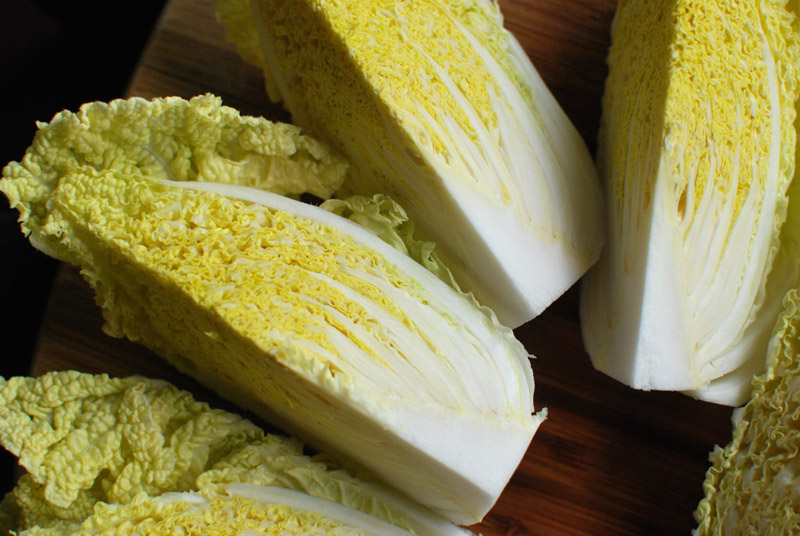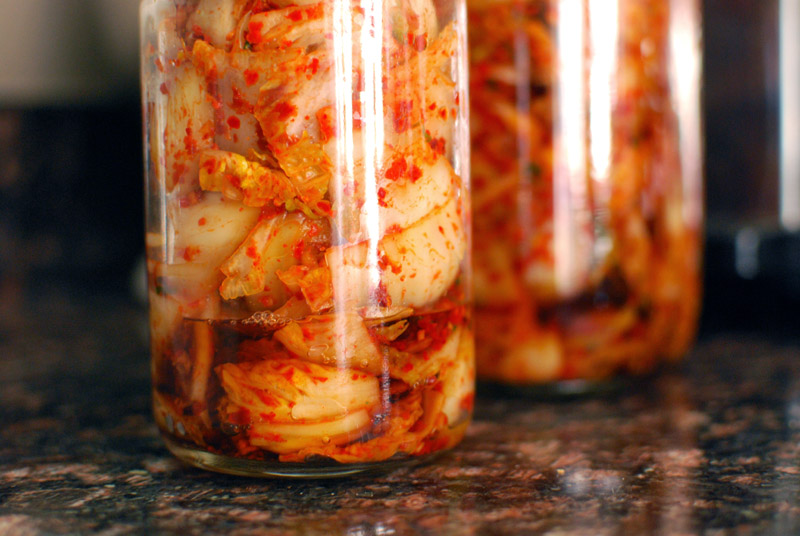
One of my favorite parts of eating Korean food (and I do love me some Korean food) is the kimchi that invariably comes with the bowl of bi bim bap, or plate of bulgogi. Korean cuisine is noted for the number of banchan (loosely translated as “side dishes”) that are served, but kimchi is undoubtedly the most common, and is served at every meal.
Kimchi is most often made from Napa cabbage, and usually fermented, though there are a staggering number of variations that may or may not involve cabbage at all. There’s even a variation called white kimchi that uses no chili at all, though kimchi is typically renowned for its tear-inducing level of heat.

There are different kimchis for the different seasons, and major differences between North Korean and South Korean kimchi, as well as town-specific varieties. This version comes from Lillian Chou, former Food Editor of our dearly departed Gourmet Magazine, and is a fast and easy version that can be finished with minimal effort. Rather than being fermented for days, this version is more of a pickle, needing only a few hours rest. Though some might frown on the non-traditional method, the result is fresh and vibrant, tasting young and crisp.
I first tried this recipe last March, when I made a batch of steamed pork buns, and wanted a little crunchy spice in the filling. I was so impressed with the ease and excellent results that I immediately made a second batch as soon as the first was gone. For a couple of months, I artfully (and sometimes not so artfully) worked handfuls of kimchi into nearly every dinner, scrambled eggs were dotted liberally with the stuff, snacks consisted mainly of a small plate of kimchi, and I lunched more often than I should have on bowls of rice, shelled edamame, and kimchi.

And then, I suppose, I grew weary of it; like a record you listen to exclusively for weeks on end and then suddenly can’t stand even the thought of it. My kimchi jar stayed empty, and I was forced to pack peanut butter sandwiches for lunch again.
But then, in the midst of a recent spate of single-digit-degree days, the hunger came upon me, and kimchi was the only cure. One key ingredient to authentic kimchi is Korean chili pepper flakes; but unfortunately, I didn’t have any, and it was far too cold to venture out in search. In substitution, I used a mixture of the more widely available crushed red pepper flakes and an Asian-style chili garlic sauce, which brought an appropriate heat with a greater depth of flavor than would be possible with only the red pepper flakes.

Mixed together with fresh ginger, garlic, and scallions, the chili pepper mixture tastes reasonably authentic. I would describe the level of heat as “moderately burning”; enough to make your eyes water if you eat a handful, potent enough to announce its presence when used in small doses in cooking, but not so overwhelming as to obscure the flavor of the other ingredients. Feel free to adjust the amounts used, based on the heat level of your chilies and personal preference. You can always add more, but you can’t take it out.
The characteristically robust and slightly funky flavor of kimchi, usually achieved through fermentation, is here mimicked with fish sauce, giving a slight nod to the South Korean style which often uses anchovies. An Asian pear grated into the mixture provides a light sweetness, rounding out the overall flavor without being insistent.

A batch of this kimchi will last about 1 month in the refrigerator, giving you ample time to use what may seem like a staggering amount, especially as a little goes a long way. If you need inspiration for ways to use it up, a quick search online will turn up recipes for kimchi soup, kimchi stir fry, kimchi pancakes, or any number of entrées to serve with kimchi.
The process is extremely simple. The cabbage is cut down to size.

It then gets tossed with salt, and is left to rest for 2 hours.

The salting process draws excess water out of the cabbage, meaning that your kimchi will stay crisp in the refrigerator for weeks. Otherwise, the cabbage would quickly wilt and go mushy.

While the cabbage sits, the other ingredients are prepared. Ginger and garlic get minced together.

Sesame seeds get toasted in a pan over medium heat until fragrant, only a minute or three.

I like to just mix everything together, though you can also purée the garlic and ginger with the other liquids to make a smooth paste if you like. Me, I don’t like to do so many dishes.

Rinse and drain the cabbage, and give your hands a little workout by squeezing all the liquid out of it. You can’t hurt it; it will still stay crunchy, though it looks wilted now. Add to the other ingredients, and mix. If you use your hands, you might want to wear rubber gloves so you don’t accidentally burn your eyes later when you rub them. Tongs work just as well, though.

Taste it to make sure it’s spicy enough for you. Be sure to store it in glass, or some other non-reactive container, that has a tight-fitting lid. I use a tall 1 1/2 liter canning jar with a swing-top lid. As the kimchi sits in the refrigerator, it will begin to ferment, and will start to smell a little more pungent; unless you like kimchi-flavored milk and butter, you might want to invest the seven dollars in a proper storage container.
Quick Kimchi
Adapted from Lillian Chou
Ingredients:
- 3 pounds Napa cabbage (about 1 large head)
- 3 tablespoons salt
- 3 cloves garlic, finely minced (about 2 tablespoons)
- 1 tablespoon fresh ginger, peeled and finely minced
- 3 tablespoons toasted sesame seeds, crushed slightly with side of heavy knife or in mortar
- 2 tablespoons Asian fish sauce
- 2 teaspoons white vinegar
- 2 tablespoons Asian-style chili garlic sauce (or to taste)
- 2 tablespoons crushed red pepper flakes (or to taste)
- 1 bunch scallions, halved lengthwise and cut into 1 inch lengths (about 1 cup)
- 1 Asian pear (about 8 ounces), peeled
Directions:
- Quarter the cabbage lengthwise. Cut crosswise into 1 to 2 inch pieces. Toss with the salt in a large bowl and let stand for 2 hours, tossing occasionally.
- Rinse the cabbage very well with cold water, being sure to wash off as much of the salt as possible. Let drain in a colander.
- While the cabbage drains, mince the garlic and ginger as finely as possible. Toast the sesame seeds in a pan over medium heat for about 2 minutes, or until fragrant. Chop the scallions, and peel the Asian pear.
- In a large non-reactive bowl, combine the garlic, ginger, sesame seeds, fish sauce, vinegar, chili garlic sauce, red pepper flakes, and scallions. Using a coarse grater, grate the peeled Asian pear into the mixture, avoiding the core and seeds.
- Using your hands, squeeze out as much liquid as possible from the cabbage, and add to the other ingredients. Toss the mixture well, and let marinate about 1 hour at room temperature. The kimchi is now ready to serve, but will keep about 1 month in the refrigerator, and will increase in pungency as it sits.
























